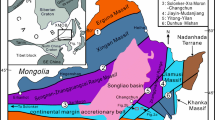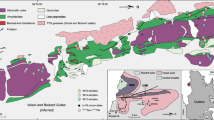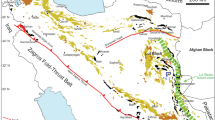Abstract
The Mundwara alkaline plutonic complex (Rajasthan, north-western India) is considered a part of the Late Cretaceous–Palaeogene Deccan Traps flood basalt province, based on geochronological data (mainly 40Ar/39Ar, on whole rocks, biotite and hornblende). We have studied the petrology and mineral chemistry of some Mundwara mafic rocks containing mica and amphibole. Geothermobarometry indicates emplacement of the complex at middle to upper crustal levels. We have obtained new 40Ar/39Ar ages of 80–84 Ma on biotite separates from mafic rocks and 102–110 Ma on whole-rock nepheline syenites. There is no evidence for excess 40Ar. The combined results show that some of the constituent intrusions of the Mundwara complex are of Deccan age, but others are older and unrelated to the Deccan Traps. The Mundwara alkaline complex is thus polychronous and similar to many alkaline complexes around the world that show recurrent magmatism, sometimes over hundreds of millions of years. The primary biotite and amphibole in Mundwara mafic rocks indicate hydrous parental magmas, derived from hydrated mantle peridotite at relatively low temperatures, thus ruling out a mantle plume. This hydration and metasomatism of the Rajasthan lithospheric mantle may have occurred during Jurassic subduction under Gondwanaland, or Precambrian subduction events. Low-degree decompression melting of this old, enriched lithospheric mantle, due to periodic diffuse lithospheric extension, gradually built the Mundwara complex from the Early Cretaceous to Palaeogene time.











Similar content being viewed by others
References
Bailey DK, Woolley AR (2005) Repeated, synchronous magmatism within Africa: timing, magnetic reversals, and global tectonics. In: Foulger GR, Natland JH, Presnall DC, Anderson DL (eds) Plates, plumes and paradigms. Geological Society of America Special Paper 388, pp 365–377
Barker DS (1974) Alkaline rocks of North America. In: Sorensen H (ed) The alkaline rocks. Wiley, London, pp 160–171
Basu AR, Renne PR, DasGupta DK, Teichmann F, Poreda RJ (1993) Early and late alkali igneous pulses and a high-3He plume origin for the Deccan flood basalts. Science 261:902–906
Berger GW, York D (1981) Geothermometry from 40Ar/39Ar dating experiments. Geochim Cosmochim Acta 45:795–812
Bhushan SK, Chandrasekaran V (2002) Geology and geochemistry of the magmatic rocks of the Malani igneous suite and Tertiary alkaline province of western Rajasthan. Geol Surv Ind Mem 126:179
Bladon AJ, Clarke SM, Burley SD (2015) Complex rift geometries resulting from inheritance of pre-existing structures: insights and regional implications from the Barmer Basin rift. J Struct Geol 71:136–154
Bose MK, Das Gupta DK (1973) Petrology of the alkali syenites of the Mundwara magmatic suite, Sirohi, Rajasthan, India. Geol Mag 110:457–466
Chakraborti MK (1979) On the alkali syenites of Mundwara suite, Sirohi district, Rajasthan. Proc Ind Nat Acad Sci 45:284–292
Chakraborti MK, Bose MK (1978) Theralite-melteigite-carbonatite association in Mer ring of Mundwara suite, Sirohi district, Rajasthan. J Geol Soc Ind 19:454–463
Cordier C, Clément J-P, Caroff M, Hémond C, Blais S, Cotten J, Bollinger C, Launeau P, Guille G (2005) Petrogenesis of coarse-grained intrusives from Tahiti Nui and Raiatea (Society Islands, French Polynesia). J Petrol 46:2281–2312
Coulson AL (1933) The geology of Sirohi state, Rajputana. Geol Surv Ind Mem 63:166
Cox KG (1978) Flood basalts, subduction, and the breakup of Gondwanaland. Nature 274:47–49
Cucciniello C, Melluso L, Morra V, Storey M, Rocco I, Franciosi L, Grifa C, Petrone CM, Vincent M (2011) New 40Ar–39Ar ages and petrogenesis of the Massif d’ Ambre volcano, northern Madagascar. In: Beccaluva L, Bianchini G, Wilson M (eds) Volcanism and evolution of the African lithosphere. Geological Society of America Special Paper 478, pp 281–282. doi: 10.1130/2011.2478(14)
Cucciniello C, Tucker RD, Jourdan F, Melluso L, Morra V (2016) The age and petrogenesis of alkaline magmatism in the Ampasindava Peninsula and Nosy Be archipelago, northern Madagascar. Mineral Petrol 110:309–331
Devey CW, Stephens WE (1992) Deccan-related magmatism west of the Seychelles-India rift. In: Storey BC, Alabaster T, Pankhurst RJ (eds) Magmatism and the causes of continental break-up. Geological Society, London Special Publications 68, pp 271–291
Dharma Rao CV, Santosh M, Kim SW, Li S (2013) Arc magmatism in the Delhi fold belt: SHRIMP U-Pb zircon ages of granitoids and implications for Neoproterozoic convergent margin tectonics in NW India. J Asian Earth Sci 78:83–99
Eby GN, Kochhar N (1990) Geochemistry and petrogenesis of the Malani igneous suite, north peninsular India. J Geol Soc Ind 36:109–130
Foland KA (1983) 40Ar/39Ar incremental heating plateaus for biotites with excess argon. Isot Geosci 1:3–21
Gaetani GA, Grove TL (1998) The influence of water on melting of mantle peridotite. Contrib Mineral Petrol 131:323–346
Ganerød M, Torsvik TH, van Hinsbergen D, Gaina C, Corfu F, Werner S, Owen-Smith TM, Ashwal LD, Webb SJ, Hendriks BWH (2011) Palaeoposition of the Seychelles microcontinent in relation to the Deccan Traps and the Plume Generation Zone in Late Cretaceous-Early Palaeogene time. In: Van Hinsbergen DJJ, Buiter SJH, Torsvik TH, Gaina C, Webb SJ (eds) The formation and evolution of Africa: a synopsis of 3.8 Ga of Earth history. Geological Society, London Special Publications 357, pp 229–252
Grove TL, Bryan WB (1983) Fractionation of pyroxene-phyric MORB at low pressure: an experimental study. Contrib Mineral Petrol 84:293–309
Ivanov AV, Demonterova EI, Rasskazov SV, Yasnygina TA (2008) Low-Ti melts from the southeastern Siberian Traps large igneous province: evidence for a water-rich mantle source? J Earth Syst Sci 117:1–22
Iwata N, Kaneoka I (2000) On the relationships between the 40Ar–39Ar dating results and the conditions of basaltic samples. Geochem J 34:271–281
Just J, Schulz B, de Wall H, Jourdan F, Pandit MK (2011) Monazite CHIME/EPMA dating of Erinpura granitoid deformation: implications for Neoproterozoic tectono-thermal evolution of NW India. Gondwana Res 19:402–412
Kaneoka I (1974) Investigation of excess argon in ultramafic rocks from the Kola Peninsula by the 40Ar/39Ar method. Earth Planet Sci Lett 22:145–156
Karmalkar NR, Duraiswami RA, Jonnalagadda MK, Griffin WL (2014) Mid-Cretaceous lamproite from the Kutch region, Gujarat, India: genesis and tectonic implications. Gondwana Res 26:942–956
Kelley S (2002) Excess argon in K–Ar and Ar–Ar geochronology. Chem Geol 188:1–22
Kent RW, Pringle MS, Muller RD, Saunders AD, Ghose NC (2002) 40Ar/39Ar geochronology of the Rajmahal basalts, India, and their relationship to the Kerguelen plateau. J Petrol 43:1141–1153
Lanphere MA, Dalrymple GB (1976) Identification of excess 40Ar by the 40Ar/39Ar age spectrum technique. Earth Planet Sci Lett 32:141–148
Leake BE, Woolley AR, Arps CES et al (1997) Nomenclature of amphiboles: report of the Subcommittee on amphiboles of the International Mineralogical Association Commission on new minerals and mineral names. Min Mag 61:295–321
Ludwig KR (2012) Isoplot/Ex, v. 3.75, Berkeley Geochronol Center Special Publication 5
McDougall I, Harrison TM (1999) Geochronology and thermochronology by the 40Ar/39Ar method, 2nd edn. Oxford University Press, Oxford
Melluso L, Morra V, Brotzu P, Tommasini S, Renna MR, Duncan RA, Franciosi L, d’Amelio F (2005) Geochronology and petrogenesis of the Cretaceous Antampombato–Ambatovy complex and associated dyke swarm, Madagascar. J Petrol 46:1963–1996
Middlemost EAK (1989) Iron oxidation ratios, norms and the classification of volcanic rocks. Chem Geol 77:19–26
Molina JF, Moreno JA, Castro A, Rodríguez C, Fershtater GB (2015) Calcic amphibole thermobarometry in metamorphic and igneous rocks: new calibrations based on plagioclase/amphibole Al–Si partitioning and amphibole/liquid Mg partitioning. Lithos 232:286–305
Morimoto N, Fabrie SJ, Ferguson AK, Ginzburg IV, Ross M, Seifert FA, Zussman J, Aoki K, Gottardi G (1988) Nomenclature of pyroxenes. Am Mineral 73:1123–1133
Nimis P (1999) Clinopyroxene geobarometry of magmatic rocks. Part 2. Structural geobarometers for basic to acid, tholeiitic and mildly alkaline magmatic systems. Contrib Mineral Petrol 135:62–74
Nimis P, Ulmer P (1998) Clinopyroxene geobarometry of magmatic rocks, Part 1. An expanded structural geobarometer for anhydrous and hydrous, basic and ultrabasic systems. Contrib Mineral Petrol 133:122–135 (with erratum in 133:314)
Pande K, Sheth HC, Bhutani R (2001) 40Ar–39Ar age of the St. Mary’s Islands volcanics, southern India: record of India–Madagascar break-up on the Indian subcontinent. Earth Planet Sci Lett 193:39–46
Pouchou JL, Pichoir F (1988) A simplified version of the “PAP” model for matrix corrections in EPMA. In: Newbury DE (ed) Microbeam analysis. San Francisco Press, San Francisco, pp 315–318
Rathore SS, Venkatesan TR, Srivastava RK (1996) Mundwara alkali igneous complex, Rajasthan, India: chronology and Sr isotope characteristics. J Geol Soc India 48:517–528
Ray JS, Ramesh R, Pande K, Trivedi JR, Shukla PN, Patel PP (2000) Isotope and rare earth element chemistry of carbonatite–alkaline complexes of Deccan volcanic province: implications to magmatic and alteration processes. J Asian Earth Sci 18:177–194
Ray JS, Pattanayak SK, Pande K (2005) Rapid emplacement of the Kerguelen plume-related Sylhet Traps, eastern India: evidence from 40Ar–39Ar geochronology. Geophys Res Lett 32:L10303. doi:10.1029/2005GL022586
Renne PR (1995) Excess 40Ar in biotite and hornblende from the Noril’sk 1 intrusion, Siberia: implications for the age of the Siberian Traps. Earth Planet Sci Lett 131:165–176
Renne PR, Swisher CC, Deino AL, Karner DB, Owens TL, DePaolo DJ (1998) Intercalibration of standards, absolute ages and uncertainties in 40Ar/39Ar dating. Chem Geol 145:117–152
Ridolfi F, Renzulli A (2012) Calcic amphiboles in calc-alkaline and alkaline magmas: thermobarometric and chemometric empirical equations valid up to 1130 °C and 2.2 GPa. Contrib Mineral Petrol 163:877–895
Roddick JC, Cliff RA, Rex DC (1980) The evolution of excess argon in Alpine biotites—a 40Ar/39Ar analysis. Earth Planet Sci Lett 48:185–208
Roeder PL, Emslie RF (1970) Olivine-liquid equilibrium. Contrib Mineral Petrol 29:275–289
Samson SD, Alexander EC Jr (1987) Calibration of the international 40Ar–39Ar dating standard, MMhb-1. Chem Geol 66:27–34
Sen A, Pande K, Hegner E, Sharma KK, Dayal AM, Sheth HC, Mistry H (2012) Deccan volcanism in Rajasthan: 40Ar–39Ar geochronology and geochemistry of the Tavidar volcanic suite. J Asian Earth Sci 59:127–140
Sharma KK (2007) K-T magmatism and basin tectonism in western Rajasthan, India, results from extensional tectonics and not from Réunion plume activity. In: Foulger GR, Jurdy DM (eds) Plates, plumes, and planetary processes. Geological Society of America Special Paper 430, pp 775–784
Simonetti A, Goldstein SL, Schmidberger SS, Viladkar SG (1998) Geochemical and Nd, Sr and Pb isotope data from Deccan alkaline complexes—inferences for mantle sources and plume-lithosphere interaction. J Petrol 39:1847–1864
Spencer JJ, Lindsley DH (1981) A solution model for coexisting iron-titanium oxides. Am Mineral 66:1189–1202
Srivastava RK (1989) Alkaline and peralkaline rocks of Rajasthan. In: Leelanandam C (ed) Alkaline rocks. Geological Society of India Memoir 15, pp 3–24
Steiger RH, Jager E (1977) Subcommission on geochronology: convention on the use of decay constants in geo- and cosmochronology. Earth Planet Sci Lett 36:359–362
Storey M, Mahoney JJ, Saunders AD, Duncan RA, Kelley SP, Coffin MF (1995) Timing of hotspot-related volcanism and the breakup of Madagascar and India. Science 267:852–855
Streckeisen AL (1974) Classification and nomenclature of plutonic rocks. Recommendations of the IUGS subcommission on the systematics of igneous rocks. Geol Rund 63:773–785
Subrahmanyam NP, Leelanandam C (1989) Differentiation due to probable liquid immiscibility in the Musala pluton of the Mundwara alkali igneous complex, Rajasthan, India. In: Leelanandam C (ed) Alkaline rocks. Geological Society of India Memoir 15, pp 25–46
Subrahmanyam NP, Leelanandam C (1991) Geochemistry and petrology of the cumulophyric layered suite of rocks from the Toa pluton of the Mundwara alkali igneous complex, Rajasthan. J Geol Soc India 38:397–411
Subrahmanyam NP, Rao GVU (1977) Petrography, geochemistry and origin of the carbonatite veins of Mer pluton, Mundwara igneous complex, Rajasthan. J Geol Soc India 18:306–322
Subrahmanyam NP, Murali AV, Rao GVU (1972) Age of Mundwara igneous complex—Rajasthan. Current Sci 41:63–64
Tindle AG, Webb PC (1994) Probe-AMPH—a spreadsheet program to classify microprobe-derived amphibole analyses. Comput Geosci 20:1201–1228
Tucker RD, Ashwal LD, Torsvik TH (2001) U-Pb geochronology of Seychelles granitoids: a Neoproterozoic continental arc fragment. Earth Planet Sci Lett 187:27–38
Verma SP, Torres-Alvarado IS, Sotelo-Rodriguez ZT (2002) SINCLAS: standard igneous norm and volcanic rock classification system. Comput Geosci 28:711–715
Vijayan A, Sheth H, Sharma KK (in press) Tectonic significance of dykes in the Sarnu-Dandali alkaline complex, Rajasthan, northwestern Deccan Traps Geosci Front. doi:10.1016/j.gsf.2015.09.004
Viswanathan S (1977) Differentiated dyke rocks of Mer Mundwara, Rajasthan and their metallogenic significance. Geol Mag 144:291–298
Wan B, Xiao W, Windley BF, Yuan C (2013) Permian hornblende gabbros in the Chinese Altai from a subduction-related hydrous parent magma, not from the Tarim mantle plume. Lithosphere 5:290–299
Wones DR, Eugster HP (1965) Stability of biotite: experiment, theory, and application. Am Mineral 50:1228–1272
Acknowledgments
Field work was supported by Grant 09YIA001 to Sheth from the Industrial Research and Consultancy Centre (IRCC), IIT Bombay. We thank Reshma Shinde and Laiq S. Mombasawala for valuable help with the ICPAES analyses at SAIF, IIT Bombay. Funds for EPMA analyses by Cucciniello were provided by Italian MIUR (PRIN Grants 2010–2011 to Leone Melluso). Pande acknowledges Grant No. IR/S4/ESF-04/2003 from the Department of Science and Technology (Govt. of India) towards the development of the IIT Bombay—DST National Facility for 40Ar/39Ar Geo-thermochronology. Pande also thanks the IRCC, IIT Bombay, for maintenance support to the Facility (grant 15IRCCCF04). Vijayan was supported by a Ph.D. Scholarship from the University Grants Commission (UGC), Govt. of India. Jagadeesan thanks Dr. A. Dash, Head, IP and AD, BARC and Dr. S. V. Thakare, IP and AD, BARC, for encouragement and support. Fred Jourdan’s detailed review of an earlier version of this paper is greatly appreciated. The present manuscript considerably benefitted from careful journal reviews by Morgan Ganerød and Nilanjan Chatterjee, and the editorial handling of Axel Gerdes.
Author information
Authors and Affiliations
Corresponding author
Electronic supplementary material
Below is the link to the electronic supplementary material.
Rights and permissions
About this article
Cite this article
Pande, K., Cucciniello, C., Sheth, H. et al. Polychronous (Early Cretaceous to Palaeogene) emplacement of the Mundwara alkaline complex, Rajasthan, India: 40Ar/39Ar geochronology, petrochemistry and geodynamics. Int J Earth Sci (Geol Rundsch) 106, 1487–1504 (2017). https://doi.org/10.1007/s00531-016-1362-8
Received:
Accepted:
Published:
Issue Date:
DOI: https://doi.org/10.1007/s00531-016-1362-8




